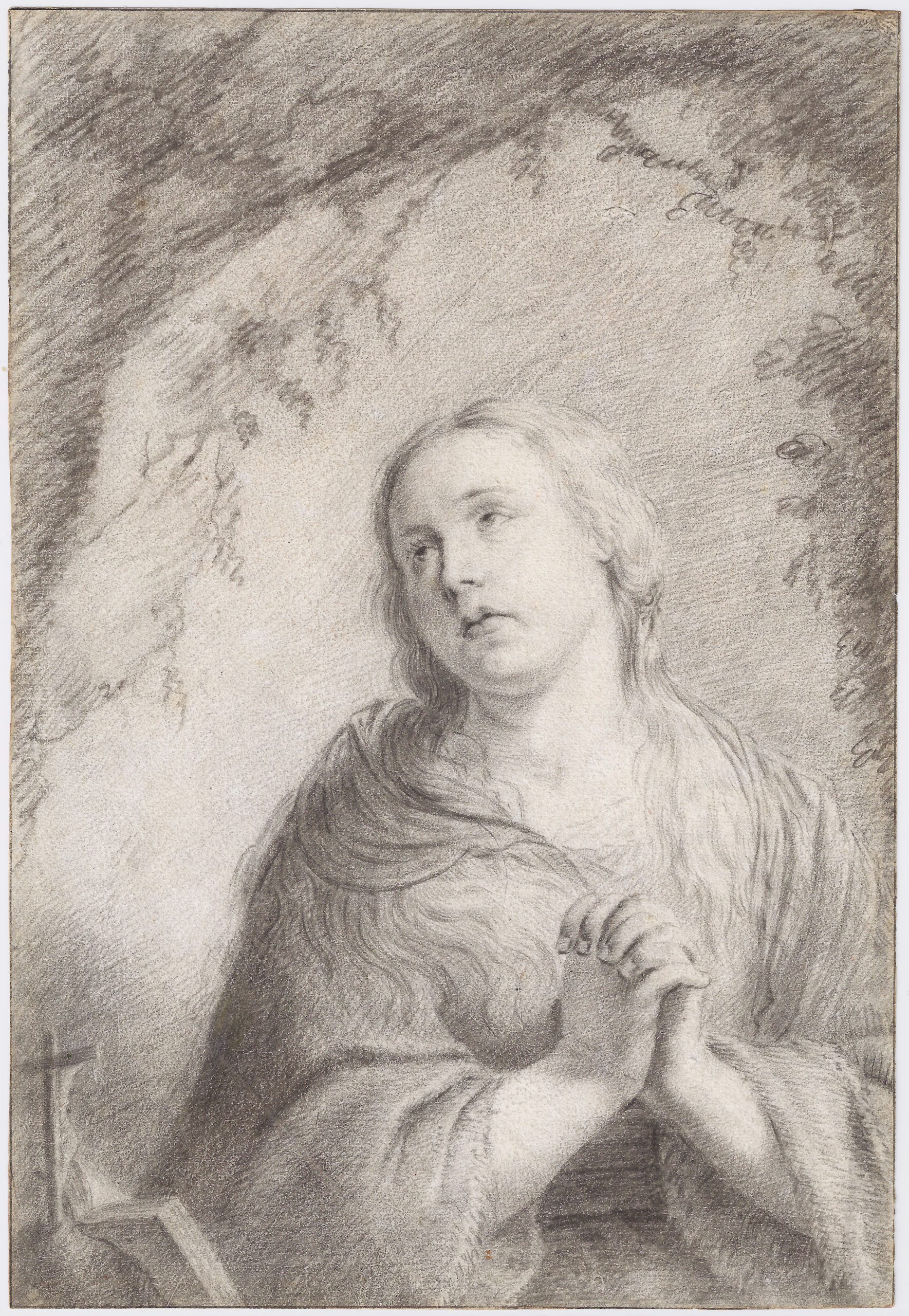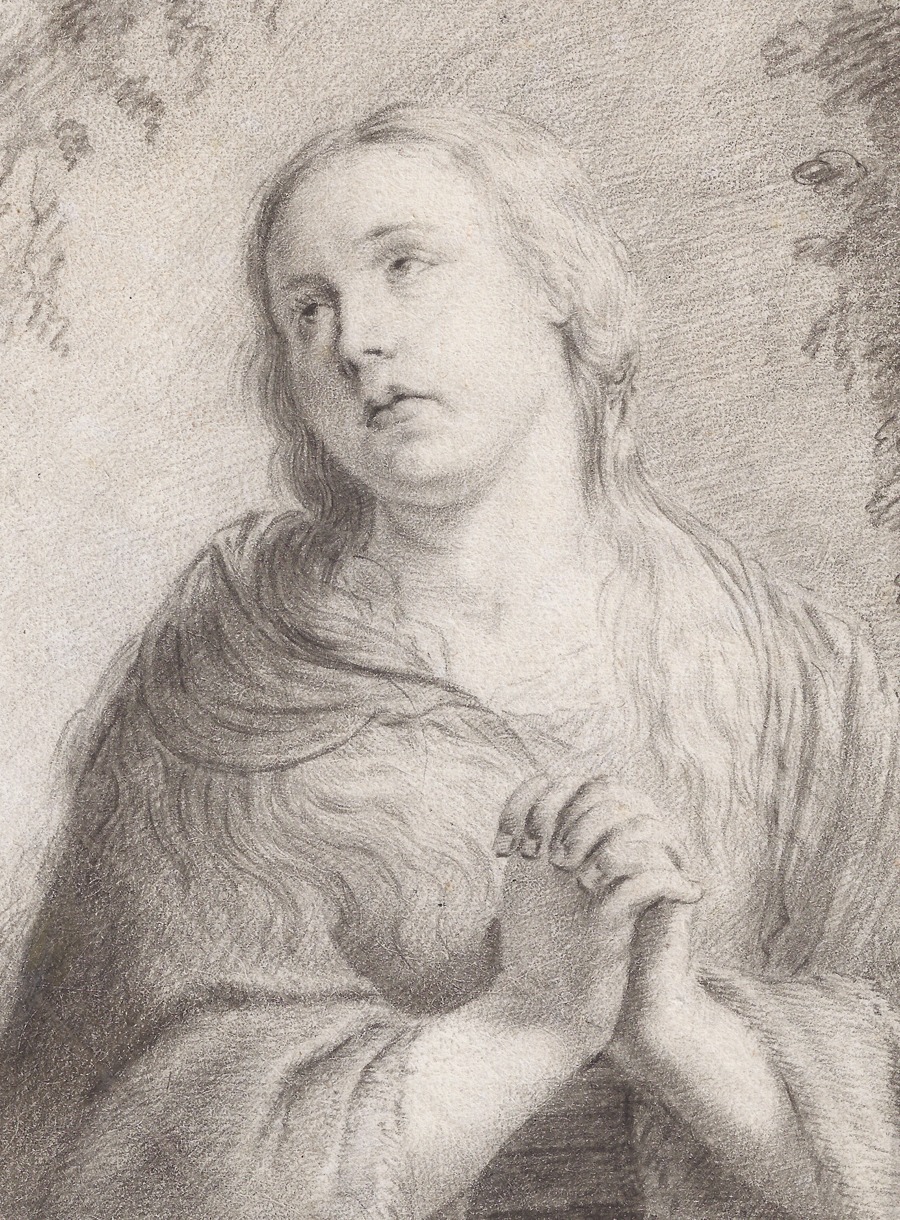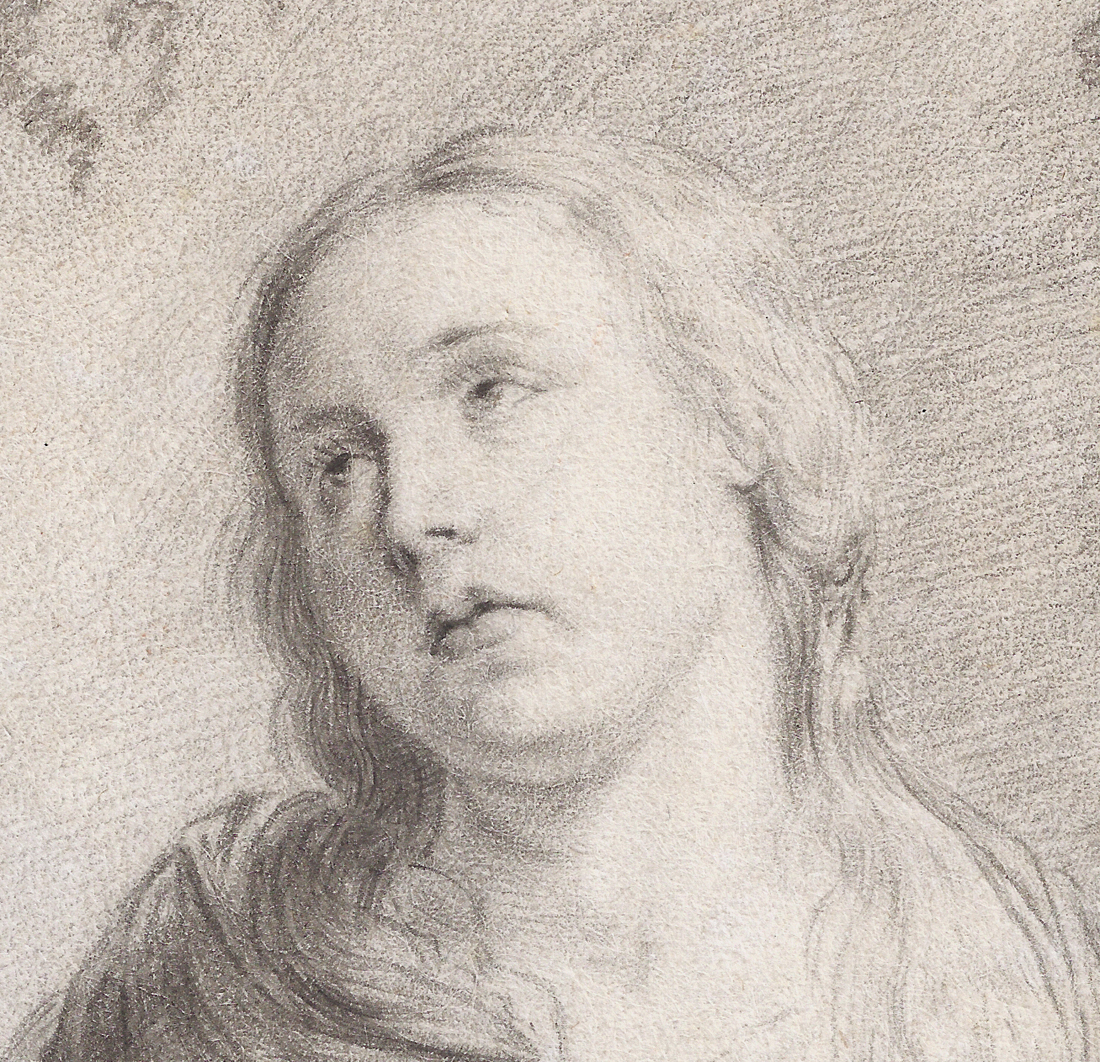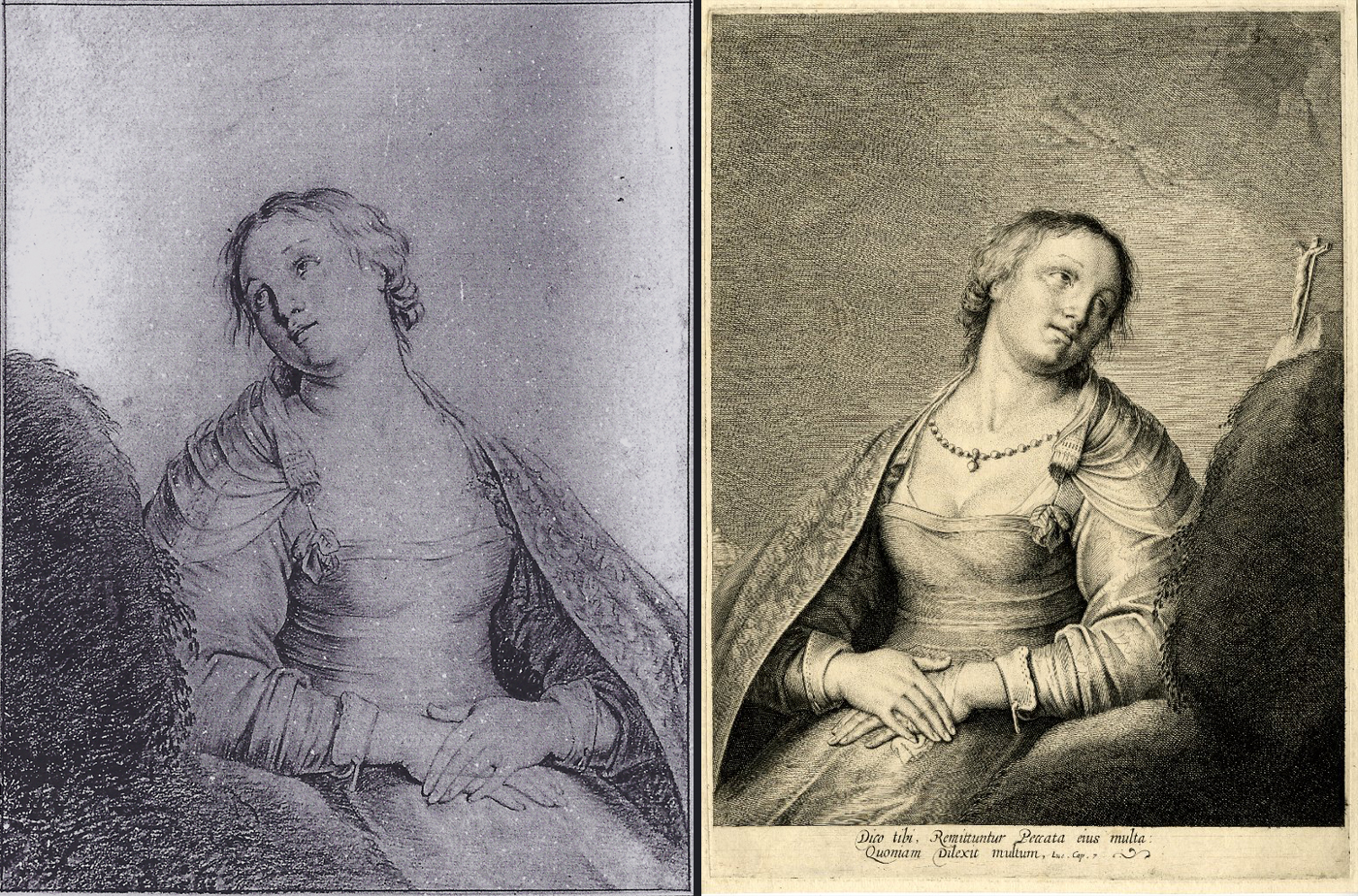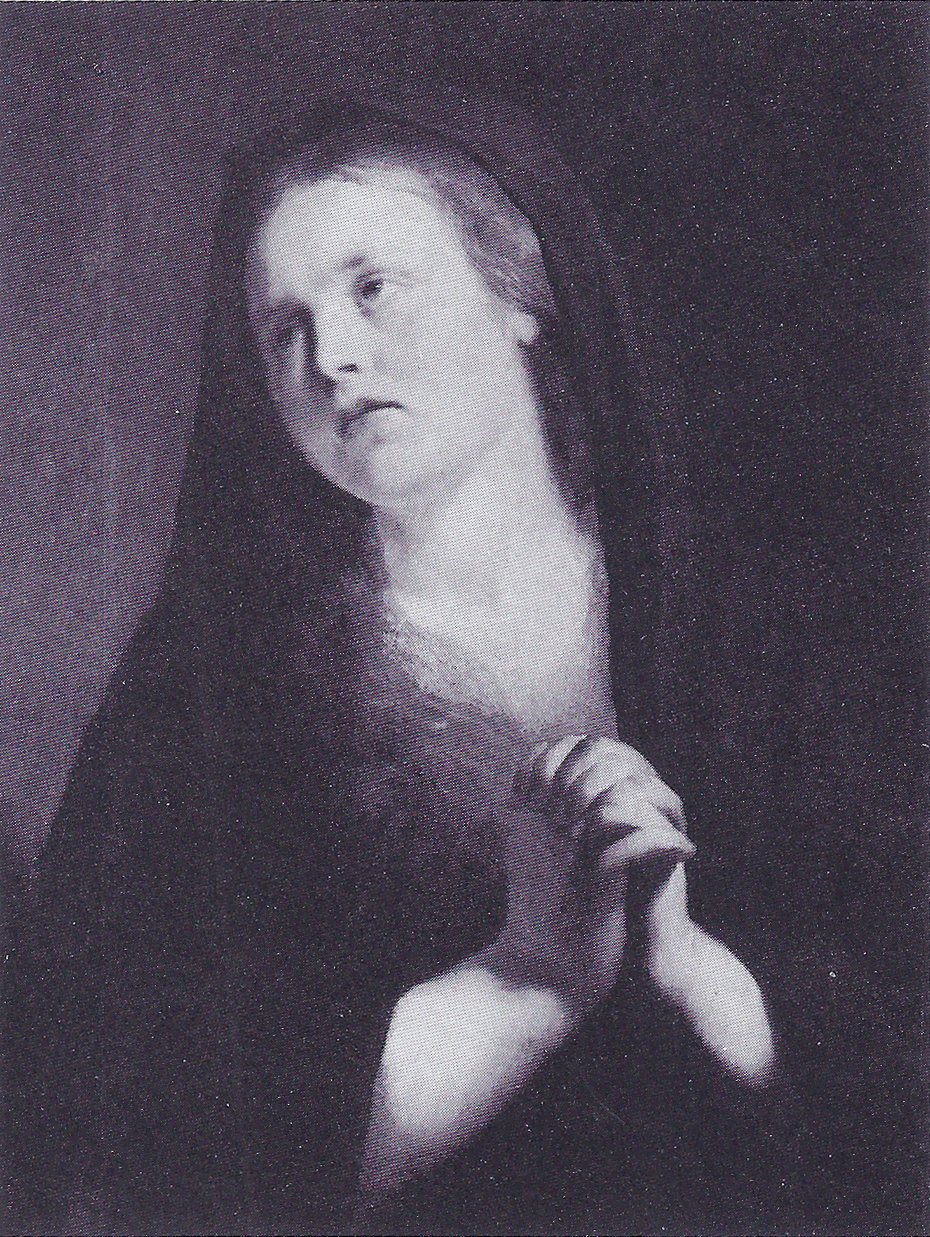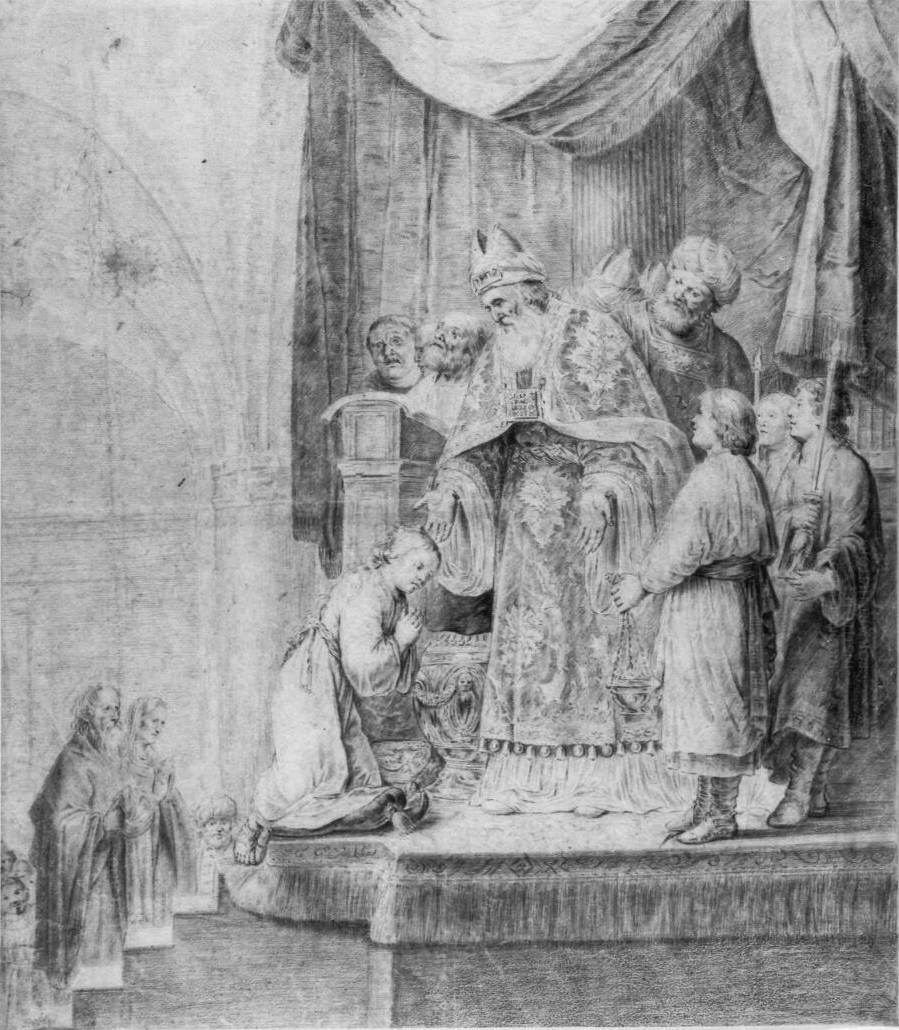PIETER FRANSZ DE GREBBER (Haarlem c. 1600 – 1652/53 Haarlem)
Pieter Fransz de Grebber (Haarlem c. 1600 – 1652/53 Haarlem)
The Penitent Magdalen
Black chalk, grey ink framing lines, 288 x 197 mm
Inscribed ‘J.C.’ (pencil, verso), and inscribed ‘J. de Braij.’ in an 18th-century hand (pencil, on a separate piece of paper mounted on the verso)
Provenance
~ Sale Amsterdam, 4 March 1765, Album K, no. 4
~ Private collection, The Netherlands
Literature
J.W. von Moltke, ‘Jan de Bray’, Marburger Jahrbuch für Kunstwissenschaft, vols. 11-12, 1938-9, p. 498, no. Z-32 (‘Die Hlg. Magdalena. In Halbfigur dargestellt. 290 x 197 mm. Schwarze Kreide.’),1
***
Pieter de Grebber trained in the studio of his father, Frans Pietersz de Grebber (1573–1649), one of the leading painters of histories and portraits in the early decades of the seventeenth century in Haarlem.2 Like his father, Pieter primarily painted religious works, but he also produced around twenty portraits. Though he did not join the Haarlem painters’ guild until 1632, Pieter had begun painting portraits by 1621, when he was mentioned by Samuel Ampzing in his Beschrijvinge ende lof der stad Haerlem in Holland. Almost all of De Grebber’s portraits were of local Catholic clerics like his portrait of Philippus Rovenius of 1631 (Museum Catharijneconvent, Utrecht). His first history painting, Caritas, dates of 1622 (Frans Hals Museum, Haarlem). De Grebber successfully fused his father’s detailed approach with a more intense sense of naturalism and dramatic lighting.
This recently re-discovered sheet is a further indication of De Grebber’s Catholic sympathies. The subject, the Penitent Magdalen, her eyes raised imploringly upwards to heaven, with hands folded and a small crucifix and prayer book in front of her, has strong Catholic connotations. The vigorously drawn background suggests a cave setting, with foliage hanging down, and alludes to the wilderness in which the Magdalen withdrew to contemplate her worldly sins – the scene would have stimilated similar contemplation in contemporary viewers. The utter devoutness of the saint would appear to have been influenced by Italian painting of the period, in particular by Guido Reni (1575–1642), some of whose works were collected in the Dutch Republic. In fact the present drawing has an exceptional Italianate flavour, rarely encountered in Dutch art of the period.
Pieter de Grebber is not much known as a draughtsman today.3 He does however seem to have been quite active in the medium: the collection of Samuel van Huls (1655–1734), mayor of The Hague, included no less than forty-one drawings by De Grebber.4 The devout subject, composition, facial type and handling of the drawing are similar to a drawing of the Penitent Magdalen in the Staatliche Museen, Berlin; the drawing was also engraved (fig.).5 The crucifix and cave-like background, present in the print but not in the preparatory drawing in Berlin, are reminiscent of our sheet. The composition of the figure of the Magdalen in our drawing is near-identical to that in a painting on the art market in 1986 (fig.).6
Most of De Grebber’s surviving drawings are rather loose and sketchy in character. Only a few of his finished drawings survive, intended either to be engraved as with the Berlin drawing, as presentation models or as works of art in their own right for collectors. A highly finished drawing of the Presentation of Mary in the Temple is kept in the Schlossmuseum, Weimar (fig.).7 The characteristic diagonal regular hatching making up large areas of the background in our drawing is comparable to the backgrounds of a group of sixteen drawings in the Rijksprentenkabinet with scenes from the Acts of the Apostles.8
SOLD
1. Von Moltke seems to have included this drawing in his catalogue raisonné of the works of Jan de Braij (c.1627–1697) only on the basis of the reference from the 1765 sale catalogue and not from examination of the original drawing. The 18th-century attribution to De Braij is not surprising, as both De Grebber and members of the De Braij family were the main protagonists of Haarlem Classicism. I am grateful to Dr Jeroen Giltaij for his comments on this drawing (email correspondence 29 September 2014).
2. For Pieter, see I. van Thiel-Stroman, ‘Pieter Fransz de Grebber’, in: Painting in Haarlem 1500-1850. The collection of the Frans Hals Museum, Ghent/Haarlem 2006, pp. 168-172 and B. Schnackenburg, ‘Jan Lievens und Pieter de Grebber’, Wallraf-Richartz-Jahrbuch 68 (2007), pp. 181-218.
3. For his drawings, see: K. Andrews, ‘On Some Drawings by Pieter de Grebber’, Master Drawings 22 (1984), pp. 294-98.
4. Van Huls sale, The Hague, 14 May 1736, no. 1977 ‘6 Titres de Livres.’; no. 1978 ‘5 Titres pour les Livres de Blason.’; no. 1984 ‘7 Histoires de la Bible.’; no. 1985 ‘La vie d’un Saint sur 4 feuilles.’; no. 1986 ‘La Nativité, d’un fort excellent dessein.’; no. 1987 ‘La Rencontre de Jacob & d’Esau & 3 autres.’; no. 1988 ‘L’Annonciation & 3 autres’; no. 1989 ‘La Pécheresse de l’Evangile & 3 autres.’; no. 1990 ‘une Bacchanale & un autre.’; no. 1991 ‘La Nativité, & un autre.’; no. 1992 ‘Simeon, & un autre’.
5. Black chalk, touches of red chalk, 242 x 187 mm; see E. Bock and J. Rosenberg, Staatliche Museen zu Berlin: die niederländischen Meister: beschreibendes Verzeichnis (...), Berlin 1930, p. 146, no. 2473. Engraving and etching, 267 x 196 mm; Hollstein 11. An impression is preserved in the British Museum, Department of Prints and Drawings, inv. no. S.6232.
6. Oil on panel, 70.8 x 51.4 cm. The painting was sold at Christie’s, London, on 17 July 1986, lot 21, as attributed to Pieter de Grebber, and is only known by the small black-and-white image in the catalogue. I am grateful to Drs Erik Löffler of the RKD for drawing my attention to this painting.
7. Black chalk, 466 x 411 mm; Stiftung Weimarer Klassik und Kunstsammlungen, Weimar, inv. no. KK 5044; see Rembrandt und seine Zeitgenossen, exh. cat. Weimar (Schlossmuseum), 1981, no. 254.
8. All black chalk, approximately 303 x 195 mm; inv. nos. RP-T-1981-92 to 107. The drawing of Paul driving the spirit out of the bondwoman at Philippi is particularly comparable (fol. 11r), see: Marijn Schapelhouman and Peter Schatborn, Dutch Drawings of the Seventeenth Century in the Rijksmuseum, Amsterdam. Artists born between 1580 and 1600, Amsterdam 1998, nos. 203a-p, pp. 96-98, repr.
